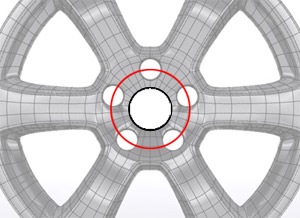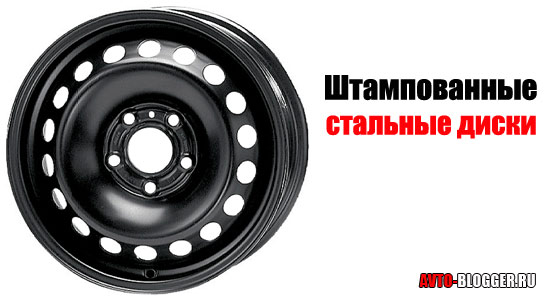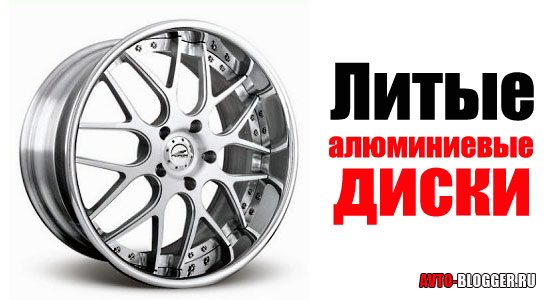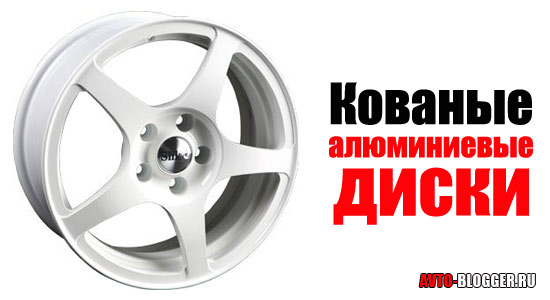Which firm drives are better. Which disks are better
If you want to change rims on your car, then you need to know a few important things to the right choice... Consider the labeling car drives... All discs have a standard parameter marking, regardless of whether it is an alloy or steel disc.
Wheel rim marking
For example: 8.5Jx18 H2 5x120 ET20 d74.1
8.5
Is the width of the disc in inches (W);
18
Is the diameter of the disc in inches (D);
5x120 Is a designation of the number of landing bolts and the diameter on which they are located. This diameter is also referred to as PCD, and it is measured in millimeters. In our case, the number of landing bolts is early 5 and the PCD is 120 mm;
ET20- disk departure. This is the distance between the mating plane of the rim (the plane that presses the rim against the hub) and the axis of symmetry of the rim (CL). Outreach (ET) is measured in millimeters. In our case, it is equal to 20 mm;
d74.1- diameter of the central hole, which is measured from the side of the mating plane. Diameter (DIA) is measured in millimeters. In our case, it is 74.1 mm. Many manufacturers alloy wheels make DIA of a larger diameter, and for centering on the hub they use adapter (centering) rings that securely fix the disc, eliminating the possibility of vibrations.
The marking also contains additional parameters J and H2, but they are of interest only to specialists.
J - this is how information about the design of the bead flanges of the disc rim is indicated. There are: J, JJ, K, JK, B, P and D.
H2 - designation of the hump construction. The humps are the annular ridges on the rim landing flanges. There are: H, H2, FH, FH2, CH, EH2, EH2 +.
Let's take a closer look at each of the disk labeling parameters.
I think that the width and diameter of the disk do not require additional decryption.
As mentioned above, PCD is the diameter of the circle on which the mounting holes are located (in the picture below, it is indicated by a red line).

If necessary, PCD can be calculated by measuring the distance between the centers of the nearest holes (this can be done with a regular ruler without removing the wheels from the car). For discs with four mounting bolts, the PCD is equal to the distance between the centers of the opposing bolts.

The following formulas are applied to calculate the PCD:
3 holes: PCD = X * 1.154
4 holes: PCD = X * 1.414
5 holes: PCD = X * 1.701
6 holes: PCD = X * 2
10 holes: PCD = X * 3.326
ATTENTION!
Since the mounting holes are made with a solid plus tolerance in diameter, you can make a mistake in choosing a PCD if it differs from the standard one by a couple of millimeters.
For example, a PCD 98x4 wheel is often put on a hub with PCD 100x4 (you cannot tell 98 mm from 100 by eye). IT IS UNACCEPTABLE. In this case, of all the nuts (or bolts), only one will be fully tightened; the rest of the holes will "take away" and the fasteners will remain under-tightened or tightened with a bias - the wheel will not fit completely on the hub. On the move, such a wheel will "beat", in addition, incompletely tightened nuts will loosen by themselves.
As we said above, offset (ET) is the distance between the mating plane of the wheel disk (the plane that presses the disk against the hub) and the axis of symmetry of the disk. The wheel offset for any vehicle model is calculated directly by the car manufacturer. Accordingly, compliance with this parameter when choosing a disc is a very important condition for its safe location in the wheel arch. The departure is allowed to change by no more than 5-7 mm.
Departure can be positive, zero and negative.

What is the departure
Zero offset means that the mating plane of the rim completely coincides with its axis of symmetry.
Positive reach: the mating plane is offset from the axis of symmetry in the outward direction (roughly speaking, towards the road, not towards the body).
With a negative value of the wheel rim offset, its mating plane, on the contrary, is shifted towards the body. Usually negative overhang is found on discs with a "deep cymbal" design.
Russian tire manufacturers also use the following wheel offset classification:
small overhang: from 0 to 30;
regular departure: from 30 to 45;
long reach: from 45 to 100;
negative overhang: -25 to 0.
ATTENTION!
Departure parameters are strictly regulated by the automaker and are closely related to the suspension kinematics. When it changes, the loads change sharply. For example, it is believed that when the overhang is reduced by 50 mm, the load on the suspension increases by 1.5 times. Simply put, the wheel begins to act as a lever, which is especially pronounced in corners when dynamic loads increase. This is due to the fact that the relationship "line of rotation - wheel center" laid down by the manufacturer is violated, as a result of which a negative or positive roll-off shoulder occurs. Its influence lies in the fact that an additional moment arises, which must be compensated by the steering wheel. The result is heavy steering and unpredictable cornering. And of course the suspension wear.
Today, I propose to think about which wheels are best for the car. In total, there are three main types that are widespread in the world. These are stamped steel, cast aluminum and forged aluminum rims... So which ones are optimal for your car? Which one is better to choose ...
So, I propose to choose based on indicators such as strength, cost, practicality and fuel consumption of the vehicle.
The first in the article are stamped versions, they are the most common
Stamped - steel types

The most common type, all because they are the cheapest, several times cheaper than cast or forged aluminum. Almost all budget cars use stamped variants. We can say with confidence that 60 - 70% of machines "put on shoes" in "stamping". The big advantage of these discs is that when hitting a hole or hitting a protruding object, curb or stone on the road, the stamped type will not crack or break, thereby preserving the suspension parts from damage. At any tire service, it will be straightened for you ( in simple words), and it will continue to serve you. However, he also has plenty of shortcomings. First, they are susceptible to corrosion, if you do not use these discs for a long time, they can rust and even rot. The second is the heaviest of the trinity, and therefore it is harder to accelerate the car, it is also more difficult to stop it. The mass of the vehicle's sprung space has also been increased, which negatively affects the operation of the suspension. Fuel consumption with "stamping" on the wheels is increased by about 7 - 10%.
The second in the article will tell you about the cast aluminum options.
Cast - aluminum

Manufactured from aluminum alloy, without using high pressure. The combination of price and quality. No, of course, they are much more expensive than stamped ones, but they are not as expensive as forged options. Lighter than steel by about 15 - 20%. They are also very aesthetic in appearance, have many designs, colors and shapes. Due to the light weight, the suspension of the car has a lower spring pressure, which has a good effect on the dynamics and braking of the car, and also has a positive effect on the consumption of the car. Consumption is less than on a car with stampings. But they also have disadvantages, "casting" is not resistant to deformation, when hitting an obstacle, it can crack or even break. They can no longer be restored. In you can see how they are produced. It should be noted that more and more manufacturers are shoeing their cars in these options, they have a lot of advantages.
And the last in our article are "forged aluminum"
Forged - Aluminum Wheels

Forged - are made using semi-liquid stamping technology. The most expensive of the trinity, but also the lightest, they are up to 50% lighter than stamped ones and up to 25% lighter than "cast" ones. It is also worth noting that they are the most practical of the trinity, they are elastic and do not break with a sharp hit on an unevenness. A car with this look consumes less fuel, and the suspension lives longer, due to the lowest weight. Disadvantages - limited types of design due to the complex technology of the manufacturing process.
I would like to say a few words about titanium options ... These also happen in the car markets, but the guest is very rare and very expensive, several times more expensive than the forged brother. However, they are the strongest and lightest of all. But I do not advise you to take them, because the price of an ordinary foreign car (radius 15 - 16) will be equal to the price of two - three sets of "casting".
The answer to the question - which disks are better, everyone should determine for themselves. Everything is not unambiguous here. Someone is not ready to spend a lot of money on cast and forged aluminum wheels, while for someone it is not acceptable to use stamped wheels.
Watch a useful video where the guy touches on all the main points of the choice
This concludes my article, read our AUTOBLOG, subscribe to updates on social networks.
As soon as a person gets his own "wheels", a lot of problems immediately appear, the "horseless" citizen is not familiar. One of these headaches is the choice of wheels.
Despite the fact that the showcases of car dealerships amaze the imagination with the assortment, according to the method of production wheel disks are divided into only three types: stamped, cast and forged.
Each type has its pros and cons. We will understand them with the help of our auto instructors .
Steel rims
Stamped discs have been in use for as long as there has been mass production of cars, and until the 80s of the last century, motorists simply did not have an alternative.
The method for producing such discs is simple: two halves of the future disc are cut out of a straight piece of steel by a press mold. Then the inner and outer parts are spot welded. Then it remains to apply a protective anti-corrosion coating - and the disc is ready.
Advantages of stamping:
- Low cost and, accordingly, price. A domestically produced disc costs an average of 500 to 1,500 rubles.
- High ductility, due to which the disc absorbs the energy of the impact upon impact, protecting the suspension and tire.
- Maintainability - The bent disc can be aligned for reuse.
- Wheels with such disks are not in great demand among car drivers.
Disadvantages of a stamped disc:
- Great weight. Manufacturing technology does not allow to reduce the thickness of the metal without loss of strength characteristics. Therefore - huge pressure on the chassis, a longer braking distance, fuel consumption and a large number of related troubles.
- Unpresentable appearance... Again, the technology does not allow obtaining complex structures. Discs have to be covered with caps.
- Low corrosion resistance. Especially on inexpensive models, where the coating is applied using a simplified technology.
Alloy wheels
Alloy wheels are made from aluminum alloys by casting. It is logical, right? Casting is carried out in three methods - chill casting, low pressure casting and back pressure casting. The performance of the wheel depends on the manufacturing method.
Thus, discs obtained under low pressure surpass die casting by 1.5-2 times in ductility and by 15-20% in strength. And casting under back pressure improves mechanical properties by another 5-10%.
Also, cast wheels differ in the material of manufacture. The most common alloy of aluminum with silicon. Such wheels are 15-30% lighter than steel ones. Magnesium alloy wheels are the lightest, but also the most fragile. In addition, magnesium has a low corrosion resistance, which requires a strong protective coating to be applied to such discs.
Casting pros:
- Lower weight compared to a stamped wheel. Accordingly, the driving performance of the car is improved, the load on the suspension is less, and the rubber wear is less. In addition, the heat dissipation characteristics of such discs prevent the brakes from overheating.
- The technology allows for many design options. If you need a car to look good, then molding is the best solution.
Cons of alloy wheels:
- The main disadvantage of such wheels is their fragility. When hitting a disc, it can easily crack. There is no need to explain what this means for the safety of the vehicle.
- Poor corrosion resistance and galvanic vapor formation with steel parts. This is especially noticeable on discs made of magnesium alloys. Violation of the protective coating can be the beginning of the process of destruction of the disc.
Of course, on disks made in compliance with all the rules, the risk of destruction is minimized, but the market is flooded with products Low quality and of unknown origin. So there is always a chance to get discs on your car that can fall apart on the very first curb.
Prices alloy wheels depend on the manufacturer and vary from 1,500 to 30,000 rubles.
Forged wheels
Indeed, it is somewhat inappropriate to call “forged” wheels made by the technology of hot forging in closed matrices. But, since such a name has taken root among the people, we will leave it for ease of understanding.
So, "forged" wheels are a purely Russian invention. They appeared in those years when the defense industry needed to survive. So inventive comrades came up with the idea of making automobile wheels using equipment hitherto used in the aerospace industry.
Hence the high cost of such products - disks are made in the course of a multistage technological process with the use of presses developing an effort from 6 to 20 kilotons. Such presses cost tens of millions of dollars and are available in only a few enterprises, both in Russia and abroad, and therefore the manufacturers of forged discs can be counted on one hand.
The process allows to achieve a uniform and fine structure of aluminum alloy, "forged" rims are so light and durable.
And dear ones. Although, it depends from what position to judge. If a Russian citizen has to buy a “forging” at a price of 4-7 thousand rubles, then abroad the same disc will cost over a thousand euros.
Dignity forged wheels:
- Light weight. Two times lighter than steel, 30-40% lighter than cast.
- High impact ductility. It is almost impossible to split a quality wheel. And when dents appear, you can correct it.
- Corrosion resistance.
Disadvantages of forging:
- Relatively high price. The cheapest "forged" is twice as expensive as the cheapest cast.
- Unassuming design. Theoretically, it is possible to obtain a shape of any degree of openwork, but "forged" discs are much thinner than cast ones, and therefore beauty will worsen the strength data.
By the way, this is one of those types of products that are exported. So, if someone craves for a foreign "forging", most likely, they will purchase a product made from our blanks.
And here is a video on the topic of choosing the types of wheels for your car:
What to put on your car, everyone decides for himself. Cheapness, appearance, safety and excellent driving performance of your car - everyone has something to choose for themselves.
 Architecture of a distributed control system based on a reconfigurable multi-pipeline computing environment L-Net "transparent" distributed file systems
Architecture of a distributed control system based on a reconfigurable multi-pipeline computing environment L-Net "transparent" distributed file systems Email sending page Fill relay_recipients file with addresses from Active Directory
Email sending page Fill relay_recipients file with addresses from Active Directory Missing language bar in Windows - what to do?
Missing language bar in Windows - what to do?